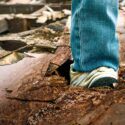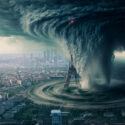Your vacation in Hawaii has taken a dangerous turn. The Earth shakes. You think it might be an earthquake, but then you see the smoke, and the lava. You always wanted to see a volcano up close, but not like this.
A volcano is an opening in the Earth’s crust through which magma, volcanic ash, and gases escape. When these materials explode into the air, it causes an eruption that can destroy everything in their path. And volcanic eruptions are responsible for 540 deaths every year.
Volcanic eruptions can be catastrophic. They can bury entire cities. Currently, there are 1,500 active volcanoes in the world, and 169 of them are in the U.S. But most of them are located along the Pacific Rim, known as the “Ring of Fire”. Hawaii’s volcanoes are part of a hot spot in the middle of the ring.
Can you predict a volcanic eruption? Could turning off the air conditioning save your life? Why would you want to stay away from water?
Step 1. Don’t take pictures
On average of 70 volcanoes erupt every year. This happens when magma reaches the surface, at which point is called lava. Explosions happen when pressure builds up in the magma, allowing lava to burst out of the top or sides of the volcano, destroying everything in its path.
If you’re in this scenario, you need to evacuate immediately. Don’t stop to take pictures, I know that a volcanic eruption can be very exciting to document, but every second is crucial if you want to make it out alive.
Step 2. Stay away from water
When hot lava is coming towards you, you might think staying in water is a good idea but not in this case. When hot volcanic materials come in contact with water from rivers, or melted snow and ice, it forms mudflows that can bury entire communities.
During the hot summer of 2019, and without any warning, a volcano erupted on New Zealand’s White Island. Of the 47 tourists there, 22 were killed, many others received severe burns and injuries, and several others were never found in the debris and water.
Step 3. Build your emergency kit
Volcanoes don’t erupt following predictable schedules. And if you are one of the 29 million people around the world that live within 10 km (6.2 mi) of active volcanoes, you’ll need to be prepared in case you have to leave the area in a hurry.
So stock the necessary supplies like non-perishable foods, enough water for several days, face masks, and cleaning supplies. In case there’s an unexpected eruption, your biological fight or fight response will deter your ability to think rationally. That’s why it is vital to practice an evacuation plan with your community and stick to it.
Step 4. Take shelter
In explosive eruptions, the magma blasts into the air and breaks apart into pieces called tephra. The biggest chunks of tephra can be the size of a house, and they can crush houses, cars and block roads.
When the boulders of tephra are already falling from the sky, it is too late to try to evacuate since you could end up crushed by them. This is where you should seek shelter in a house and close all windows, doors, and fireplace. Turn off fans and air conditioning systems. Turn on the radio or TV, listen to the local officials and follow their guidance.
Step 5. Keep the AC off
The ash that erupts into the sky will fall back to Earth like powdery snow, and if it’s thick enough, it can suffocate you. If the ash starts to fall while you are trying to evacuate the area in your car, keep the engine switched off. The ash will stall your vehicle by clogging the engine. Keep fans and air conditioning turned off. This will prevent outside air with ash from coming into the room, which is dangerous to inhale.
Sources
- “6 Tips For Surviving A Volcanic Eruption “. 2021. globalrescue.com.
- “New Zealand volcano: Divers deployed to find last two missing bodies”. 2019. BBC News.
- “Volcano Safety Tips”. 2021. redcross.org.
- “Protecting Yourself During A Volcanic Eruption|Volcanoes“. 2021. cdc.gov.
- “6 Tips For Surviving A Volcanic Eruption “. 2021. globalrescue.com.



























